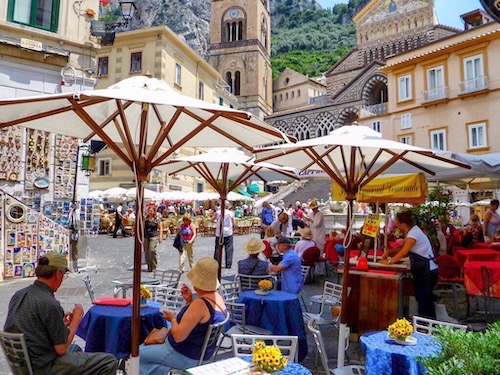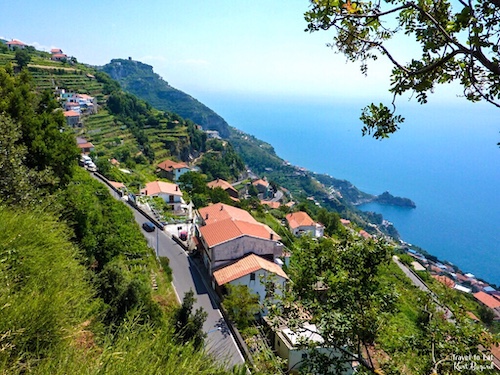
A few years ago, we traveled around Italy and I never wrote the posts. This is the beginning of a series on Italy, beginning with the Amalfi Coast, one of the most historic and beautiful regions of Europe. To see the Amalfi Coast, we hired a private driver, a wise choice given the narrow and twisting roads, who also had a love for opera. As we crested the rise into the Amalfi Coast we were treated to Botticelli along with the spectacular view. Arguably one of the most beautiful coastlines in the world, the Amalfi Coast is a 50 kilometer (31 mile) stretch along the southern edge of Italy’s Sorrentine Peninsula, in the Campania region. It is a popular holiday and tourist destination, with sheer cliffs and a rugged shoreline dotted with small beaches and pastel-colored fishing villages. Deemed by Unesco to be an outstanding example of a Mediterranean landscape, the Amalfi Coast is a combination of great beauty and gripping drama: coastal mountains plunge into the sea in a stunning vertical scene of precipitous crags, picturesque towns and lush forests. During the 10th–11th centuries, the Duchy of Amalfi existed on the territory of the Amalfi Coast, centered in the town of Amalfi. The Amalfi coast was later controlled by the Principality of Salerno, until Amalfi was sacked by the Republic of Pisa in 1137.
The Amalfi Coast
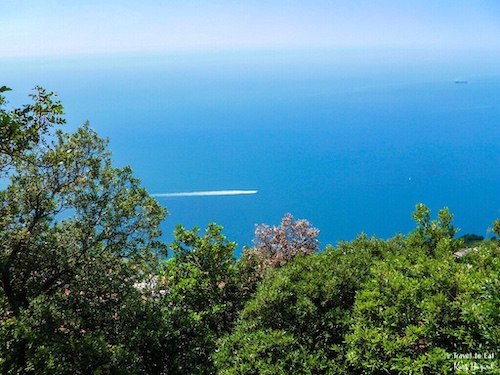
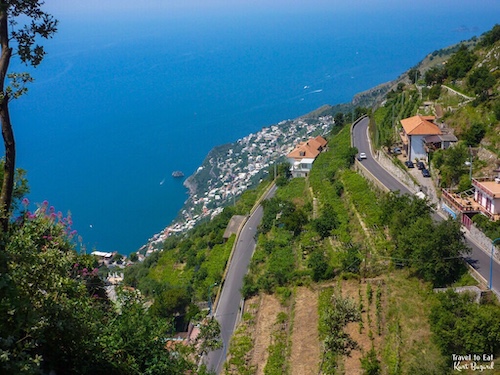
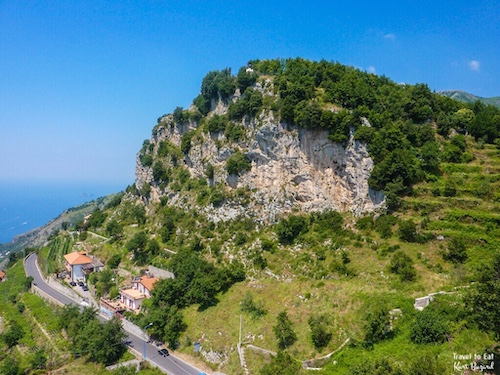
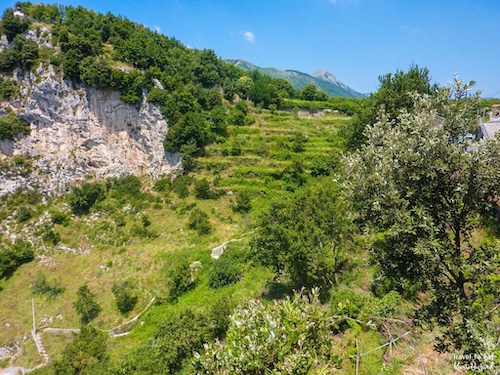
The mountain sides of the Amalfi Coast were terraced over the centuries, shaped by human labor to create flaps of arable land and already compared, during the Renaissance period, to the legendary Hesperides by the Italian writer and naturalist Giambattista Della Porta. All the towns of the Amalfi coast are connected by the scenic SS 163 road, built in the first half of the 19th century during the Bourbon period and considered one of the most beautiful roads in Italy. In June 1807 Giuseppe Bonaparte visiting the Coast was enchanted by it and decided to build a road from Naples to Amalfi. The road was completed in 1854 by Ferdinand II. Following the natural course of the coastline, the route is full of curves, nestled between the rock and the sea cliffs, giving new and spectacular shots at the exit of every tunnel or hairpin bend. Before the construction of the coastal road, locals reached all the towns via mule tracks and footpaths, still existing and particularly appreciated by hikers for the stunning views that can be enjoyed.
Amalfi History
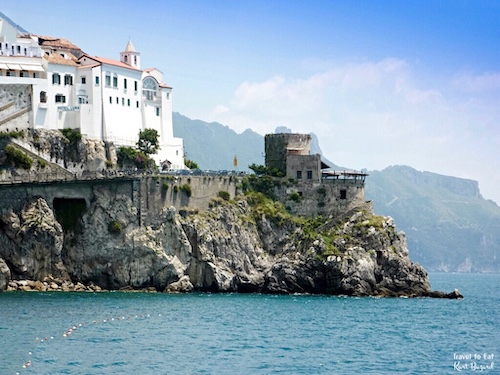
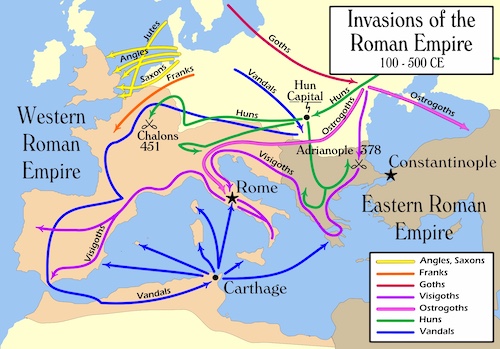
The Crossing of the Rhine in 405/6 brought unmanageable numbers of German and Alan barbarians (perhaps some 30,000 warriors, 100,000 people) into Gaul, beginning the fall of the western Roman Empire. The general decline of population, technological knowledge and standards of living in Europe during this period became the archetypal example of societal collapse for writers from the Renaissance until recent times. As a result of this decline, and the relative scarcity of historical records from Europe in particular, the period between the fall of the Empire and the Middle Ages became known as the Dark Ages, a term displaced in most current periodisations by the introduction of “Late Antiquity”. As the western Roman Empire disintegrated, civilization retreated into city states. With it’s natural protection from the steep mountains, Amalfi became a retreat from the chaos on the Italian peninsula. Amalfi has been an Episcopal seat since 596. In 839 Amalfi separated from the Ducat of Naples and became an autonomous town. The small autonomous state was governed by a count, elected each year by representatives from the noble families and then it was governed by a duke. During that period the state covered the area between Cetara and Positano, together with Capri and Li Galli isles, and in the inner part it included also Lattari mounts to Gragnano, near Naples. This was the best period for Amalfi. The Republic bought spices, precious stones, carpets and fabrics from the Arabs, and sold them throughout Italy. The Norman Tower is the biggest and the oldest one on the Amalfi Coast. This tower was built between 1250 and 1300 and represents a rare example of an increased tower to sight pirate ships coming from the south.
Amalfi
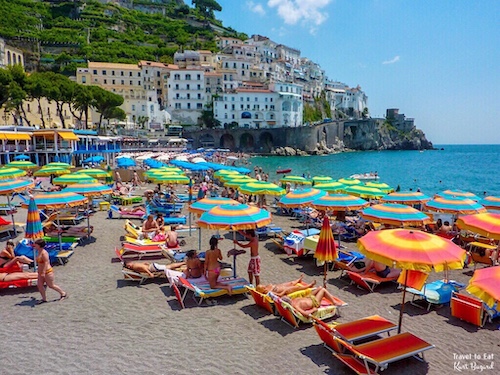
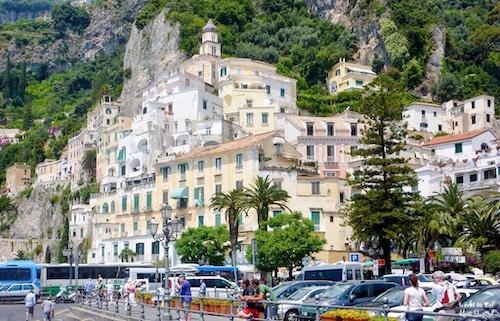
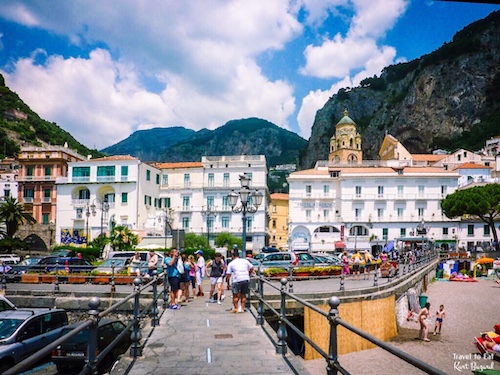
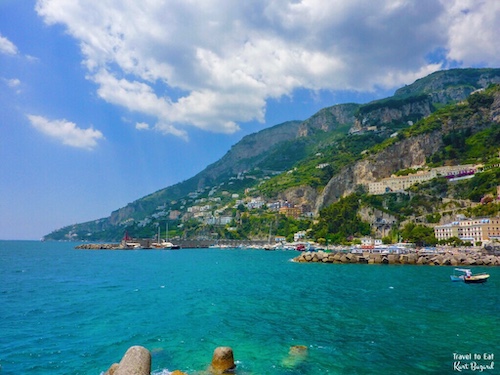
Amalfi is the main town of the coast on which it is located, named Costiera Amalfitana (Amalfi Coast), and is today an important tourist destination together with other towns on the same coast, such as Positano, Ravello and others. Amalfi is included in the UNESCO World Heritage Sites. First mentioned in the 6th century, Amalfi soon afterwards acquired importance as a maritime power, trading grain from its neighbours, salt from Sardinia and slaves from the interior, and even timber, in exchange for the gold dinars minted in Egypt and Syria, in order to buy the Byzantine silks that it resold in the West. Merchants of Amalfi were using gold coins to purchase land in the 9th century, while most of Italy worked in a barter economy. In the 8th and 9th century, when Mediterranean trade revived it shared with Gaeta the Italian trade with the East, while Venice was in its infancy, and in 848 its fleet went to the assistance of Pope Leo IV against the Saracens.
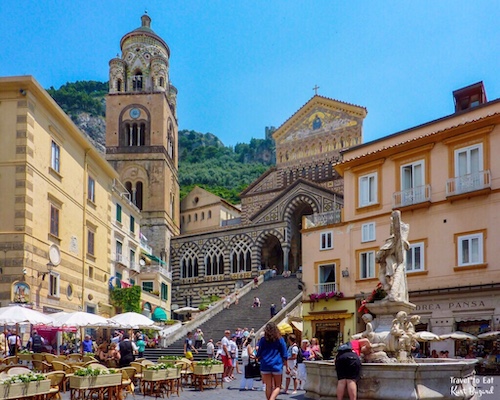
Amalfi was the first of the four Maritime Republics of Italy. It was through Amalfi that paper was introduced to Europe. Through its prowess of the seas and dominance in international trade, Amalfi drafted the most effective code of maritime law of the time, the “Tabula Amalphitana”, which was adopted by all the maritime powers of the area. The compass was reportedly first used by Amalfi ships and invented by Flavio Gioia of Amalfi, whose statue can be seen between the sea and the entrance to the city. The first documentation of the town comes from 533 AD, during the Gothic invasions, when the town passed under the dominion of the Byzantine emperor, who granted the governance of the area to the duke of Naples. During the next century, it became a bishopric, which brought considerable wealth to the town.
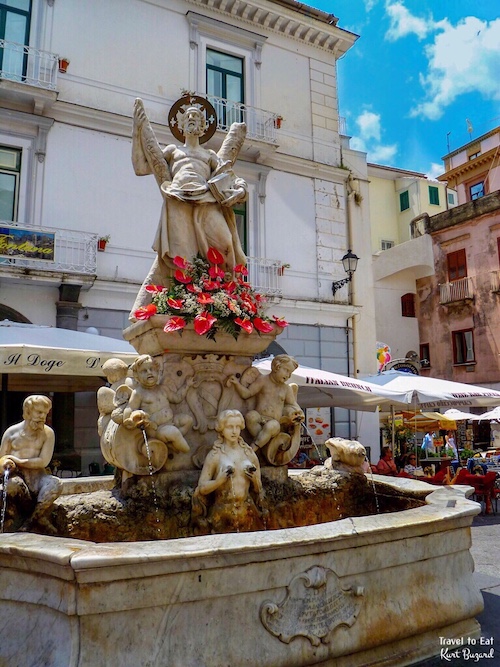
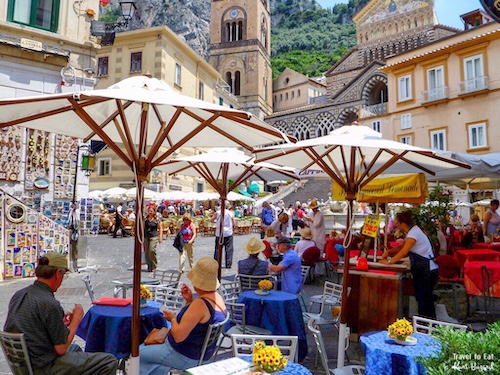
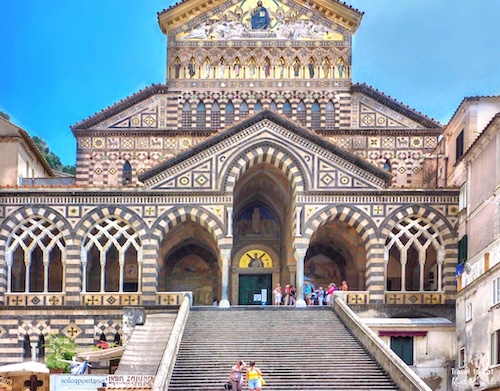
At the top of a staircase, Saint Andrew’s Cathedral (Duomo) overlooks the Piazza Duomo, the heart of Amalfi. The cathedral dates back to the 11th century; its interior is adorned in the late Baroque style with a nave and two aisles divided by 20 columns. The façade of the cathedral is Byzantine in style and is adorned with various paintings of saints, including a large fresco of Saint Andrew. In 1206, Saint Andrew’s relics were brought to Amalfi from Constantinople by the Pietro Capuano following the Sack of Constantinople (an event of the 4th Crusade) after the completion of the town’s cathedral.[6] The cathedral contains a tomb in its crypt that it maintains still holds a portion of the relics of the apostle. A golden reliquary which originally housed his skull and another one used for processions through Amalfi on holy days can also be seen.
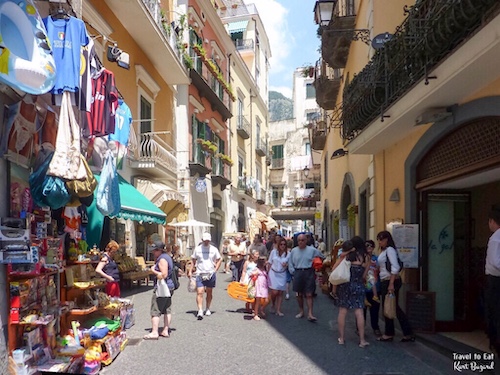
In 1135, Amalfi suffered a horrendous sacking by Pisan mercenaries who had been hired by the city to defend against Norman incursions. The city never recovered from this defeat. Two centuries later, an enormous earthquake shattered the area, destroying most of the habitations and submersing the fortifications and maritime docks. A few years later, the plague arrived, completing the destruction. Amalfi, once boasting sumptuous palaces ornate with frescoes, marble columns and fountains, with an enormous wealth acquired from all over the world, now became a modest little town eking a living from a traditional economy of fishing, local crafts and agriculture.
Museum of Handmade Paper (Museo della Carta)
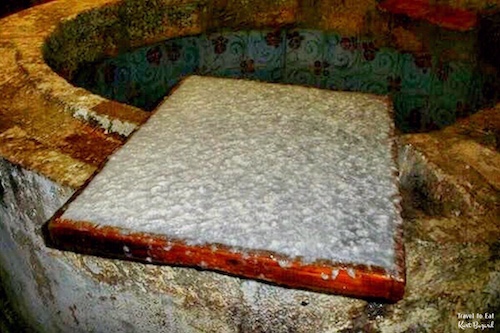
The beginning of the ancient tradition of paper making dates to around the 1st century BCE along the banks of the large river Azure in China. Thanks to adventurous merchants, paper began to arrive in the bazaars of Persia, the Syrian-Palestine border, and then onto the Muslims possessions in Sicily, Spain and North Africa. Amalfi paper, also called Charta Bambagina, is a valuable type of paper produced in Amalfi since the Middle Ages. The territories of the Maritime Republics (Amalfi, Pisa, Genoa and Venice) are among the first ones in which, in the 12th and 13th century CE, the production of paper was introduced to Europe. These Republics, thanks to the commercial relationships with the Arabic east, had the opportunity to learn the art of paper manufacturing. Between them Amalfi seems to be the first town that introduced such type of workmanship. In Amalfi a real paper industry was born. Amalfi paper owes its second name, Charta Bambagina, to the specific production process which, apart from the use of cellulose from wood, is based on the processing of rags of linen, cotton and hemp white. The fiber is dissolved in water is transformed by hand into sheets by means of frames formed by wires of brass and bronze. The majority of the paper mills were installed along “Valle dei Mulini” (Valley of the Mills). The museum is one tourist attraction you might want to visit.
Places of Note
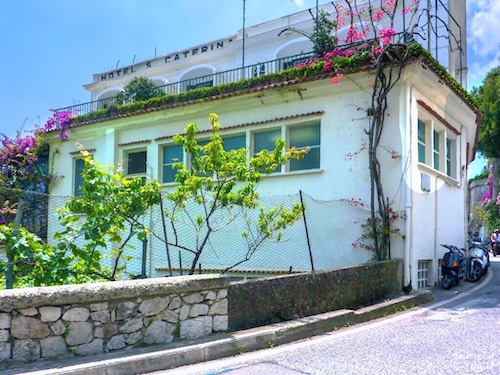
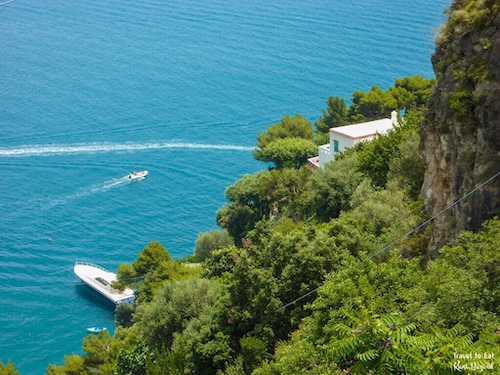
The Amalfi Coast became a fashionable tourist magnet, attracting visitors and residents as diverse as Danny de Vito, John Steinbeck, Gore Vidal, Bob Geldof, Sophia Loren and Sting, and the birth of luxury hotels like the stylish Le Sirenuse at Positano, where the Rolling Stones, U2, and Ingrid Bergman have stayed. The Santa Caterina hotel is considered by some to be the best hotel in the world. Don’t let the unimposing road level buildings fool you, the actual hotel is carved from a cliff overlooking the Mediterranean and is easily the best hotel on the Amalfi Coast. If you require some further name dropping, Kim Kardashian stayed here for her honeymoon with Kris Humphries (short lived marriage that it was).
Star Fruita Positano
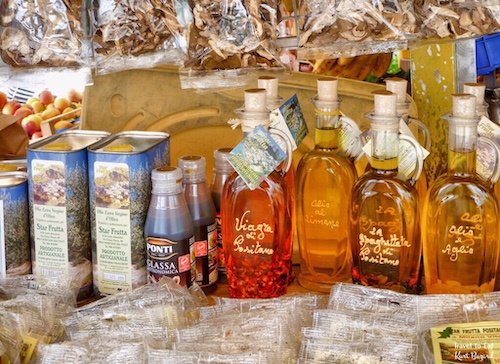
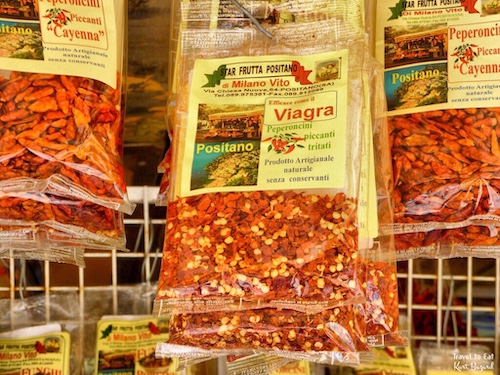
As you get closer to Positano, you begin to see more little produce stands on the side of the road. One of the most famous is the Star Frutta Positano, both for the view and for the products displayed. The cliffs of the Amalfi Coast are not only home to some of the most bright and colorful buildings in the world, but they’re also lined with garden terraces that feature olive groves, grape vines, and the always popular lemon trees. The stores throughout the alleyways boast numerous local products, including limoncello, olive oil, and orange liqueur, as well as linen clothing and breezy dresses. The Amalfi Coast is ideal for a solar café lifestyle, sun drying tomatoes or buying red hot chilli peppers advertised on a shop sign as “Viagra Naturale”, the produce stand’s tongue-in-cheek statement promising wholesome foods for a healthy lifestyle. This alluring passion and open-hearted culture is the Costiera Amalfitana way of life.
Coast of Lemons
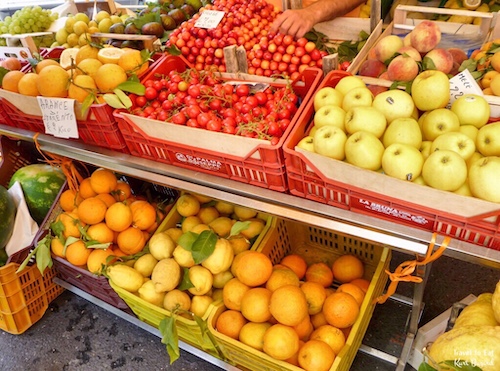
When the Royal Navy made lemon juice consumption mandatory for its sailors in 1795, Amalfi lemon cultivation hit boom time. Grabbing their machetes and spades, 17th century farmers hacked out the hillside piazzatta, or lemon terraces we see today, clinging like verdant steps along the once harsh, impenetrable strip of cliffs from Sorrento to Salerno. By the end of the 1800s this stretch of sea-facing land south of Naples had definitively become the world-renowned coast of lemons. The Amalfi lemon, Sfusato Amalfitan or Femminello St. Teresa lemon is officially recognized as unique by the PGI (Protected Geographic Indication in 2001) is no mere lemon, it’s a delicious, medicinal, landscape-making marvel. Identified by its prominent “nipple” end, pale yellow colour, high number of oil glands, and virtual lack of seeds and weighing at least 100 grams, it is the first choice for an authentic limoncello (lemon liquer).
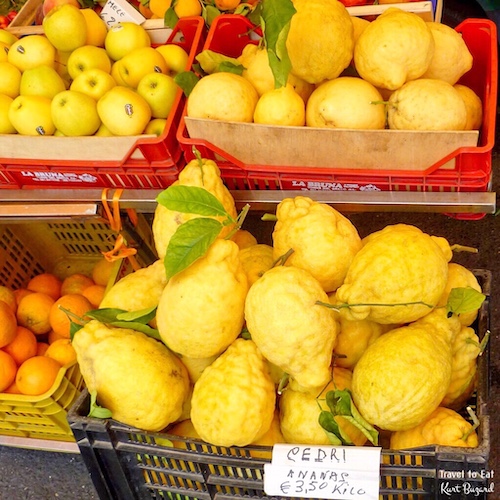
Another popular citrus ingredient on the Amalfi coast is the cedro (cedri), which looks like a huge mutant lemon, but is in fact a whole separate species. It has more pith than flesh, but the pith has none of the bitterness of the traditional lemon. Mixed with fennel, orange and a tangy lemon dressing, slices of cedro add to a refreshing, palate-cleansing salad, which Amalfitans eat in place of a sorbet between courses.
Trattoria Da Ciccio
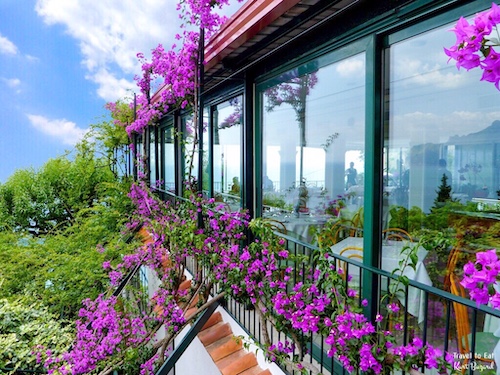

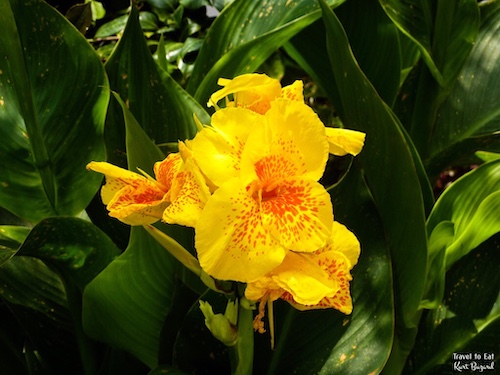
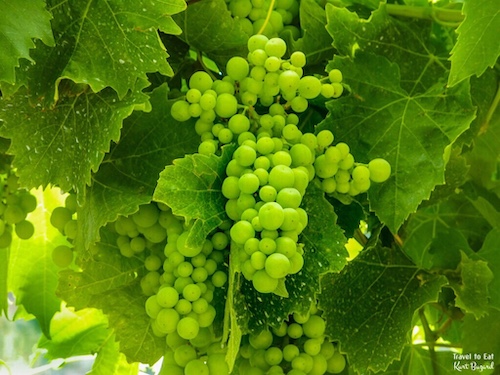
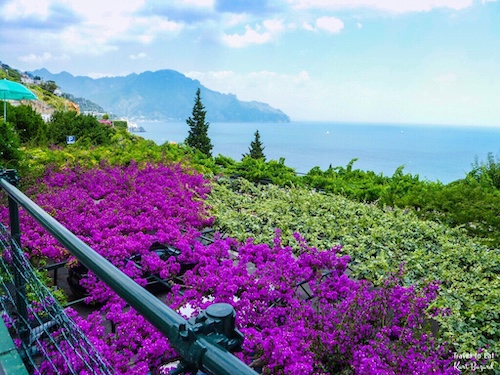
We had lunch at the Trattoria Da Ciccio, about halfway between Amalfi and Positano, rated the second best restaurant in Amalfi by TripAdvisor. It is surrounded by a lush landscape of Bougainville, greenery, flowers and grape vines. Since 1931, it has been run by the same family and it offers traditional dishes together with the new and innovative dishes, well prepared by Marco, the son of Ciccio, the owner. In addition the have a large wine cellar. The restaurant is known for the fresh fish, personally chosen by Ciccio (the owner) and for the seasonal product of his own garden. I highly recommend this restaurant, both for it’s excellent locally sourced food and the spectacular views. Sadly, my photos of the food did not turn out but I can assure you it was delicious.
Limoncello and Creammelone
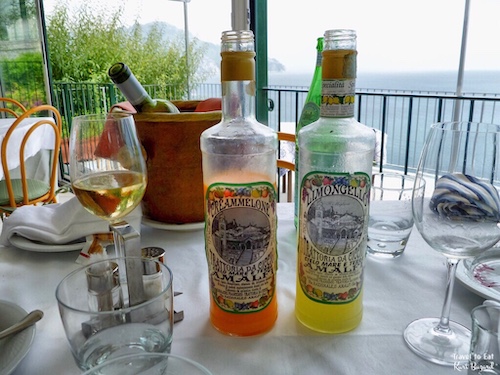
Limoncello is traditionally served chilled as an after-dinner digestivo. Along the Amalfi Coast, it is usually served in small ceramic glasses that are also chilled. This tradition has been carried into other parts of Italy. Traditionally, limoncello is made from the zest or skin of Femminello St. Teresa lemons Lemon zest, or peels without the pith, is steeped in rectified spirit until the oil is released. The resulting yellow liquid is then mixed with simple syrup. Varying the sugar-to-water ratio and the temperature affects the clarity, viscosity, and flavor. Opaque limoncellos are the result of spontaneous emulsification (otherwise known as the ouzo effect) of the sugar syrup and extracted lemon oils. Creammelone is made with the same basic method, only using melon. At the Trattoria Da Ciccio and had both their signature Limoncello and Cremmelone after lunch, both were cold and delicious.
Positano
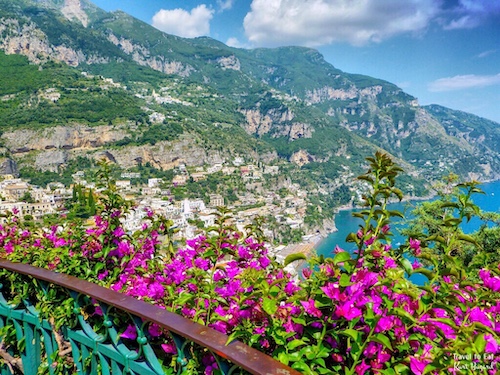
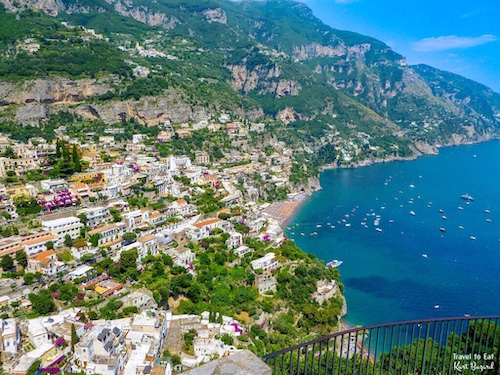
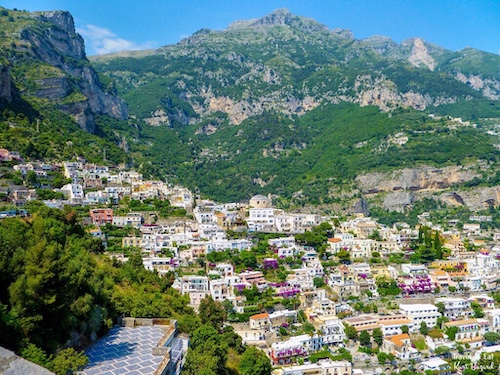
Positano was a port of the Amalfi Republic in medieval times, and prospered during the sixteenth and seventeenth centuries. By the mid-nineteenth century, however, the town had fallen on hard times. More than half the population emigrated, mostly to America. Positano was a relatively poor fishing village during the first half of the twentieth century. It began to attract large numbers of tourists in the 1950s, especially after John Steinbeck published his essay about Positano in Harper’s Bazaar in May, 1953: “Positano bites deep”, Steinbeck wrote. “It is a dream place that isn’t quite real when you are there and becomes beckoningly real after you have gone.”
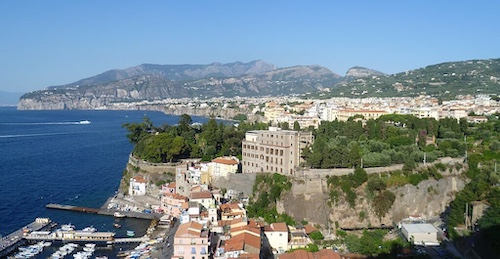
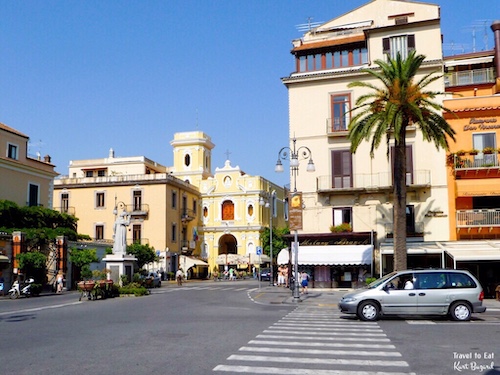
I hope you enjoyed the post, please leave a comment to let me know what you think.
[mappress mapid=”193″]
References:
Amalfi Coast: http://www.amalficoast.com/
Planning a trip to Amalfi: http://www.positano.com/en/amalfi-coast
Amalfi Paper: http://www.amalficoast.com/p/campania-4/amalfi-coast-1/amalfi-2/amalfi-s-paper-museum-2073
Amalfi Paper: http://www.museodellacarta.it/ingresso.asp?l=2
Amalfi: http://traveltips.usatoday.com/tours-amalfi-coast-italy-25466.html
Hotel Santa Carina: http://www.hotelsantacaterina.it/en/photo-gallery
Star Frutta Positano: https://www.tripadvisor.com/ShowTopic-g194863-i286-k5838334-o20-Star_Frutta_Positano-Positano_Amalfi_Coast_Campania.html
Lemon Lifestyle: http://cooking-vacations.com/815/lemon-lifestyle-visiting-italy%E2%80%99s-amalfi-coast/
Limoncello Recipe: http://www.sorrentoinfo.com/recipe-of-limoncello-sorrento/
Trattoria Da Ciccio: http://www.ristorantedaciccio.com/

